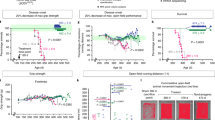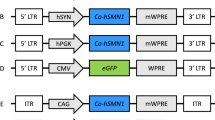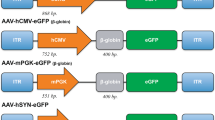Abstract
Gene transfer to spinal cord cells may be crucial for therapy in spinal muscular atrophy, amyotrophic lateral sclerosis and spinal cord injury. Lentiviral vectors are efficient for transduction of a variety of cells, but like all integrating vectors they pose a risk of insertional mutagenesis. Integration-deficient lentiviral vectors (IDLVs) remain episomal but retain the transduction efficiency of standard integrating lentiviral vectors, particularly when the episomes are not diluted out through repeated cell division. We have now applied IDLVs for transduction of spinal cord in vitro, in explants and in vivo. Our results demonstrate similar efficiency of eGFP expression from integrating lentiviral vectors and IDLVs in most cell types analyzed, including motor neurons, interneurons, dorsal root ganglia (DRG) neurons and astroglia. IDLV-mediated expression of pro-glial-cell-derived neurotrophic factor (Gdnf) rescues motor neuron cultures from death caused by removal of exogenous trophic support. IDLVs also mediate efficient RNA interference in DRG neuron cultures. After intraparenchymal injection in the rat and mouse cervical and lumbar regions in vivo, transduction is mainly neuronal, with both motor neurons and interneurons being efficiently targeted. These results suggest that IDLVs could be efficient and safer tools for spinal cord transduction in future therapeutic strategies.
This is a preview of subscription content, access via your institution
Access options
Subscribe to this journal
Receive 12 print issues and online access
$259.00 per year
only $21.58 per issue
Buy this article
- Purchase on Springer Link
- Instant access to full article PDF
Prices may be subject to local taxes which are calculated during checkout







Similar content being viewed by others
References
Naldini L, Blömer U, Gallay P, Ory D, Mulligan R, Gage FH et al. In vivo gene delivery and stable transduction of nondividing cells by a lentiviral vector. Science 1996; 272: 263–267.
Zufferey R, Nagy D, Mandel RJ, Naldini L, Trono D . Multiply attenuated lentiviral vector achieves efficient gene delivery in vivo. Nat Biotechnol 1997; 15: 871–875.
Blömer U, Naldini L, Kafri T, Trono D, Verma IM, Gage FH . Highly efficient and sustained gene transfer in adult neurons with a lentivirus vector. J Virol 1997; 71: 6641–6649.
Rahim AA, Wong AM, Howe SJ, Buckley SM, Acosta-Saltos AD, Elston KE et al. Efficient gene delivery to the adult and fetal CNS using pseudotyped non-integrating lentiviral vectors. Gene Ther 2009; 16: 509–520.
Jakobsson J, Lundberg C . Lentiviral vectors for use in the central nervous system. Mol Ther 2006; 13: 484–493.
Wong LF, Yip PK, Battaglia A, Grist J, Corcoran J, Maden M et al. Retinoic acid receptor beta2 promotes functional regeneration of sensory axons in the spinal cord. Nat Neurosci 2006; 9: 243–250.
Wong LF, Goodhead L, Prat C, Mitrophanous KA, Kingsman SM, Mazarakis ND . Lentivirus-mediated gene transfer to the central nervous system: therapeutic and research applications. Hum Gene Ther 2006; 17: 1–9.
Ralph GS, Radcliffe PA, Day DM, Carthy JM, Leroux MA, Lee DC et al. Silencing mutant SOD1 using RNAi protects against neurodegeneration and extends survival in an ALS model. Nat Med 2005; 11: 429–433.
Raoul C, Abbas-Terki T, Bensadoun JC, Guillot S, Haase G, Szulc J et al. Lentiviral-mediated silencing of SOD1 through RNA interference retards disease onset and progression in a mouse model of ALS. Nat Med 2005; 11: 423–428.
Yip PK, Wong LF, Pattinson D, Battaglia A, Grist J, Bradbury EJ et al. Lentiviral vector expressing retinoic acid receptor beta2 promotes recovery of function after corticospinal tract injury in the adult rat spinal cord. Hum Mol Genet 2006; 15: 3107–3118.
Levine BL, Humeau LM, Boyer J, MacGregor RR, Rebello T, Lu X et al. Gene transfer in humans using a conditionally replicating lentiviral vector. Proc Natl Acad Sci USA 2006; 103: 17372–17377.
Cartier N, Hacein-Bey-Abina S, Bartholomae CC, Veres G, Schmidt M, Kutschera I et al. Hematopoietic stem cell gene therapy with a lentiviral vector in X-linked adrenoleukodystrophy. Science 2009; 326: 818–823.
Baum C, Düllmann J, Li Z, Fehse B, Meyer J, Williams DA et al. Side effects of retroviral gene transfer into hematopoietic stem cells. Blood 2003; 101: 2099–2114.
Leavitt AD, Robles G, Alesandro N, Varmus HE . Human immunodeficiency virus type 1 integrase mutants retain in vitro integrase activity yet fail to integrate viral DNA efficiently during infection. J Virol 1996; 70: 721–728.
Engelman A . In vivo analysis of retroviral integrase structure and function. Adv Virus Res 1999; 52: 411–426.
Wanisch K, Yáñez-Muñoz RJ . Integration-deficient lentiviral vectors: a slow coming of age. Mol Ther 2009; 17: 1316–1332.
Saenz DT, Loewen N, Peretz M, Whitwam T, Barraza R, Howell KG et al. Unintegrated lentivirus DNA persistence and accessibility to expression in nondividing cells: analysis with class I integrase mutants. J Virol 2004; 78: 2906–2920.
Vargas JJ, Gusella GL, Najfeld V, Klotman ME, Cara A . Novel integrase-defective lentiviral episomal vectors for gene transfer. Hum Gene Ther 2004; 15: 361–372.
Lu R, Nakajima N, Hofmann W, Benkirane M, Jeang KT, Sodroski J et al. Simian virus 40-based replication of catalytically inactive human immunodeficiency virus type 1 integrase mutants in nonpermissive T cells and monocyte-derived macrophages. J Virol 2004; 78: 658–668.
Apolonia L, Waddington SN, Fernandes C, Ward NJ, Bouma G, Blundell MP et al. Stable gene transfer to muscle using non-integrating lentiviral vectors. Mol Ther 2007; 15: 1947–1954.
Philippe S, Sarkis C, Barkats M, Mammeri H, Ladroue C, Petit C et al. Lentiviral vectors with a defective integrase allow efficient and sustained transgene expression in vitro and in vivo. Proc Natl Acad Sci USA 2006; 103: 17684–17689.
Yáñez-Muñoz RJ, Balaggan KS, Macneil A, Howe SJ, Schmidt M, Smith AJ et al. Effective gene therapy with nonintegrating lentiviral vectors. Nat Med 2006; 12: 348–353.
Tolosa L, Mir M, Asensio VJ, Olmos G, Llado J . Vascular endothelial growth factor protects spinal cord motoneurons against glutamate-induced excitotoxicity via phosphatidylinositol 3-kinase. J Neurochem 2008; 105: 1080–1090.
Mir M, Asensio VJ, Tolosa L, Gou-Fabregas M, Soler RM, Llado J et al. Tumor necrosis factor alpha and interferon gamma cooperatively induce oxidative stress and motoneuron death in rat spinal cord embryonic explants. Neuroscience 2009; 162: 959–971.
Paxinos G, Franklin K . The Mouse Brain in Stereotaxic Coordinates 3rd edn Elsevier: Amsterdam, Netherlands, 2007.
Paxinos G, Watson C . The Rat Brain in Stereotaxic Coordinates 6th edn Elsevier: Amsterdam, Netherlands, 2006.
Cetin A, Komai S, Eliava M, Seeburg PH, Osten P . Stereotaxic gene delivery in the rodent brain. Nat Protoc 2006; 1: 3166–3173.
Heinzinger NK, Bukinsky MI, Haggerty SA, Ragland AM, Kewalramani V, Lee MA et al. The Vpr protein of human immunodeficiency virus type 1 influences nuclear localization of viral nucleic acids in nondividing host cells. Proc Natl Acad Sci USA 1994; 91: 7311–7315.
Gallay P, Hope T, Chin D, Trono D . HIV-1 infection of nondividing cells through the recognition of integrase by the importin/karyopherin pathway. Proc Natl Acad Sci USA 1997; 94: 9825–9830.
Bukrinsky MI, Haggerty S, Dempsey MP, Sharova N, Adzhubel A, Spitz L et al. A nuclear localization signal within HIV-1 matrix protein that governs infection of non-dividing cells. Nature 1993; 365: 666–669.
Follenzi A, Ailles LE, Bakovic S, Geuna M, Naldini L . Gene transfer by lentiviral vectors is limited by nuclear translocation and rescued by HIV-1 pol sequences. Nat Genet 2000; 25: 217–222.
Zennou V, Petit C, Guetard D, Nerhbass U, Montagnier L, Charneau P . HIV-1 genome nuclear import is mediated by a central DNA flap. Cell 2000; 101: 173–185.
Malipiero UV, Frei K, Fontana A . Production of hemopoietic colony-stimulating factors by astrocytes. J Immunol 1990; 144: 3816–3821.
Hutson TH, Verhaagen J, Yáñez-Muñoz RJ, Moon LD . Corticospinal tract transduction: a comparison of seven adeno-associated viral vector serotypes and a non-integrating lentiviral vector. Gene Ther 2012; 19: 49–60.
Sabatier J, Vives E, Mabrouk K, Benjouad A, Rochat H, Duval A et al. Evidence for neurotoxic activity of tat from human immunodeficiency virus type 1. J Virol 1991; 65: 961–967.
Barks JD, Nair MP, Schwartz SA, Silverstein FS . Potentiation of N-methyl-D-aspartate-mediated brain injury by a human immunodeficiency virus-1-derived peptide in perinatal rodents. Pediatr Res 1993; 34: 192–198.
Bao L, Guo H, Huang X, Tammana S, Wong M, McIvor RS et al. High-titer lentiviral vectors stimulate fetal calf serum-specific human CD4 T-cell responses: implications in human gene therapy. Gene Ther 2009; 16: 788–795.
Hutson TH, Foster E, Dawes JM, Hindges R, Yáñez-Muñoz RJ, Moon LD . Lentiviral vectors encoding short hairpin RNAs efficiently transduce and knockdown LINGO-1 but induce an interferon response and cytotoxicity in central nervous system neurones. J Gene Med 2012; 14: 299–315.
Zufferey R, Dull T, Mandel RJ, Bukovsky A, Quiroz D, Naldini L et al. Self-inactivating lentivirus vector for safe and efficient in vivo gene delivery. J Virol 1998; 72: 9873–9880.
Dull T, Zufferey R, Kelly M, Mandel RJ, Nguyen M, Trono D et al. A third-generation lentivirus vector with a conditional packaging system. J Virol 1998; 72: 8463–8471.
Sena-Esteves M, Tebbets JC, Steffens S, Crombleholme T, Flake AW . Optimized large-scale production of high titer lentivirus vector pseudotypes. J Virol Methods 2004; 122: 131–139.
Estevez AG, Sampson JB, Zhuang YX, Spear N, Richardson GJ, Crow JP et al. Liposome-delivered superoxide dismutase prevents nitric oxide-dependent motor neuron death induced by trophic factor withdrawal. Free Radic Biol Med 2000; 28: 437–446.
Saneto RP, De Vellis J . Neuronal and glial cells: cell culture of the central nervous system. In: Turner AJ, Brachelard HS, (eds). Neurochemistry: A Practical Approach. IRL Press: Washington DC, 1987, pp 27–63.
Cassina P, Peluffo H, Pehar M, Martinez-Palma L, Ressia A, Beckman JS et al. Peroxynitrite triggers a phenotypic transformation in spinal cord astrocytes that induces motor neuron apoptosis. J Neurosci Res 2002; 67: 21–29.
Saura J, Tusell JM, Serratosa J . High-yield isolation of murine microglia by mild trypsinization. Glia 2003; 44: 183–189.
Acknowledgements
We thank Luigi Naldini, Miguel Sena-Esteves and Rosario Osta for lentiviral, rabies envelope and Gdnf plasmids, respectively. We acknowledge Genoma España (GENAME project), the 7th EU Framework Program (PERSIST project, Grant agreement 222878), The Friends of Guy’s Hospital and Comisión de Investigación Científica (CSIC) de la UDELAR for financial support. SGA and VC were supported by PhD Studentships from the Egyptian Government and the ‘Govern Balear, Conselleria d’Innovació’, respectively.
Author contributions
RJY-M conceived the project; HP, EF, SBM, LM, GO, JL and RJY-M contributed to experimental design; HP, EF, SGA, NL, THH, PY, KW and VC-M conducted the experimental work; HP, EF and RJY-M wrote the manuscript, and all authors contributed to data analysis and commented on the manuscript.
Author information
Authors and Affiliations
Corresponding author
Ethics declarations
Competing interests
The authors declare no conflict of interest.
Rights and permissions
About this article
Cite this article
Peluffo, H., Foster, E., Ahmed, S. et al. Efficient gene expression from integration-deficient lentiviral vectors in the spinal cord. Gene Ther 20, 645–657 (2013). https://doi.org/10.1038/gt.2012.78
Received:
Revised:
Accepted:
Published:
Issue Date:
DOI: https://doi.org/10.1038/gt.2012.78
Keywords
This article is cited by
-
Safe and neuroprotective vectors for long-term traumatic brain injury gene therapy
Gene Therapy (2020)
-
Effective gene expression in the rat dorsal root ganglia with a non-viral vector delivered via spinal nerve injection
Scientific Reports (2016)
-
Comparative analysis of lentiviral vectors and modular protein nanovectors for traumatic brain injury gene therapy
Molecular Therapy - Methods & Clinical Development (2014)



